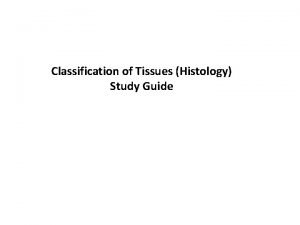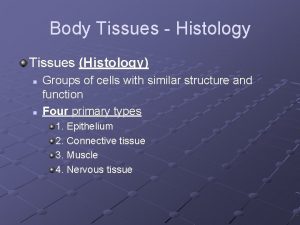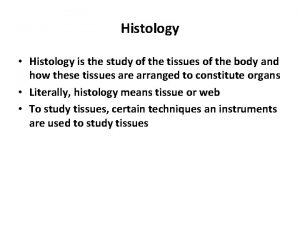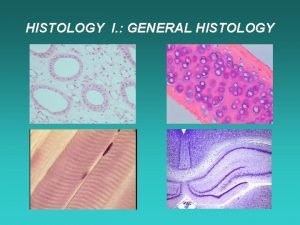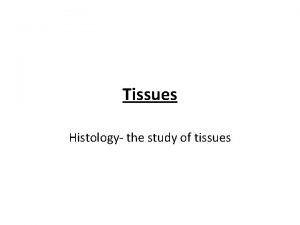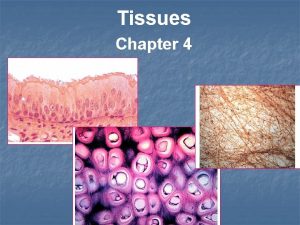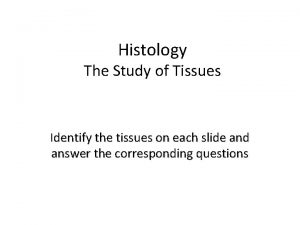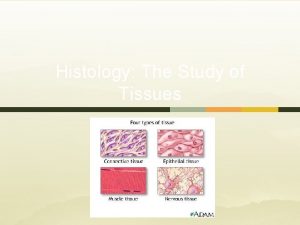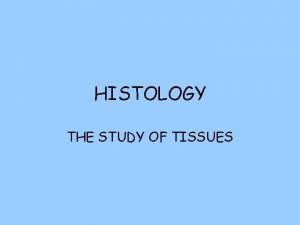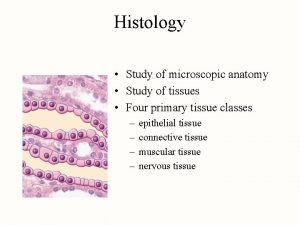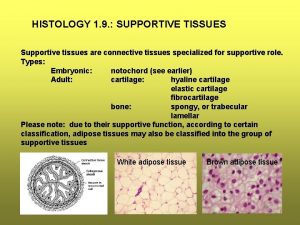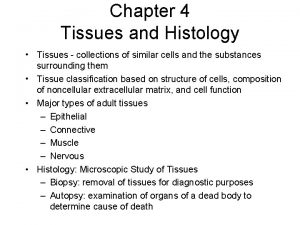Tissues Histology the study of tissues Tissues A





















- Slides: 21

Tissues Histology: the study of tissues

Tissues Ø A group of interrelated cells that function together and perform specialized activities 4 Types of Tissues in the body l Epithelial l Connective l Muscle l Nervous

Epithelial Tissue AKA: Epithelium (epi- upon or above) Ø Functions: (P) Protection (S) Secretions (A) Absorption (F) Filtration l

Epithelial Tissue Ø Characteristics l l l Closely packed flat cells Avascular (a- without vasc- blood supply), needs are met through diffusion from neighboring cells Always has an exposed surface (apical surface) Supported by connective tissue (basement membrane) Frequent cell division (mitosis)

Epithelial Tissue Ø Location l Coverings or linings of organs

Types endocrine Ø Glandular Epitheliuml Exocrine- secretes products into ducts • This allows for the substance to be concentrated to one specific area l Endocrine- secretes directly into blood • nonspecific exocrine

Epithelial Tissue Ø Epithelial tissue is classified two ways l l By the cell shape By the number of cell layers Some may contain goblet cells… these cells are filled with and release mucus. These are found in the respiratory and digestive systems.

Epithelial Cell Shapes Ø Squamous(squashed) flat, nucleus near surface Ø Cuboidal- (cube) thicker, square shaped with central nucleus

Epithelial Cell Shapes Ø Columnar- (column) elongated cells, some have microvilli (fingerlike projections that increase surface area), some have cilia (tiny hair-like structures that help move materials along)

Epithelial Cell Shapes Ø Transitionalappearance ranges from flat to columnar, cells can stretch and compress (different shapes in the same layer)

Arrangement of Layers Ø Simple- single layer, thinness allows substances to permeate easily Ø Stratified- (strat-layers) multiple layers, protection for areas that endure large amounts of stress, cells grow from the bottom layer up Ø Pseudostratified- (psuedo-false) one layer, but appears to be multilayered. All cells are attached to the basement membrane, but not all the cells reach the surface

Types of Epithelium Ø Simple Squamous- single, flat cell layer, nucleus in middle of the cell

Types of Epithelium Ø Simple Cuboidal- Single layer of cubed shaped cells, nucleus in the middle

Types continued Ø Simple Columnar- single layer of rectangular cells, nucleus at base, l Ciliated or non-ciliated- in some areas contain goblet cells (mucous) or microvilli (increase surface area)


Types- continued Ø Stratified Squamous- Several layers, larger at the bottom and flattened out at the top, bottom replaces top as the superficial layers shed, can produce keratin

Types- Continued Ø Stratified Cuboidal- two or more layers, cubed shaped cell

FYI Stratified Columnarseveral layers on columnar in superficial layers Ø Found in few places of the body (epiglottis, urethra) Ø *you will not be responsible for the identification of this type

Types Ø Pseudostratified Columnar- single layer, nucleus at different levels, all cells attached to basement membrane

Types Ø Transitional- range from squamous to cuboidal appearance

Practice Looks for at Home Review Ø Ø Epithelia Page 1. Simple Squamous 2. Simple Squamous 3. Simple Cuboidal 4. Simple Cuboidal 5. Simple Columnar 6. Simple Columnar 7. Pseudostratified Columnnar 8. Pseudostratified Columnnar (Ciliated) 9. Transitional 10. Transitional 11. Stratified Squamous 12. Stratified Squamous 13. Stratified Squamous 14. Stratified Squamous (Keratinized) 15. Stratified Squamous (Keratinized 16. Stratified (High) Cuboidal 17. Stratified Cuboidal
 Four major tissue types
Four major tissue types Body tissues chapter 3 cells and tissues
Body tissues chapter 3 cells and tissues Cells form tissues. tissues form __________.
Cells form tissues. tissues form __________. Body tissue
Body tissue Chapter 3 cells and tissues
Chapter 3 cells and tissues Pseudostratified ciliated columnar epithelium
Pseudostratified ciliated columnar epithelium Nguyên nhân của sự mỏi cơ sinh 8
Nguyên nhân của sự mỏi cơ sinh 8 Bổ thể
Bổ thể Vẽ hình chiếu đứng bằng cạnh của vật thể
Vẽ hình chiếu đứng bằng cạnh của vật thể Phản ứng thế ankan
Phản ứng thế ankan Thiếu nhi thế giới liên hoan
Thiếu nhi thế giới liên hoan Chúa yêu trần thế
Chúa yêu trần thế điện thế nghỉ
điện thế nghỉ Một số thể thơ truyền thống
Một số thể thơ truyền thống Trời xanh đây là của chúng ta thể thơ
Trời xanh đây là của chúng ta thể thơ Số nguyên tố là số gì
Số nguyên tố là số gì đặc điểm cơ thể của người tối cổ
đặc điểm cơ thể của người tối cổ Tỉ lệ cơ thể trẻ em
Tỉ lệ cơ thể trẻ em Vẽ hình chiếu vuông góc của vật thể sau
Vẽ hình chiếu vuông góc của vật thể sau Các châu lục và đại dương trên thế giới
Các châu lục và đại dương trên thế giới ưu thế lai là gì
ưu thế lai là gì Hệ hô hấp
Hệ hô hấp





